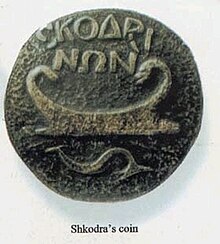
Back Ilirsko kraljevstvo BS Ilirska kraljevstva Croatian Ókori illír királyság Hungarian Regno Illirico Italian ილირიის სამეფო Georgian Илирско Кралство Macedonian Koninkrijk Illyrië (oudheid) Dutch Kraljevina Ilirija Serbo-Croatian Mbretëria e Ilirisë Albanian Краљевина Илирија Serbian
Illyrian Kingdom | |
|---|---|
| c. 400 BC–168 BC | |
 Kingdom of Illyria during Agron's reign (250 BC – 230 BC) | |
| Capital | Known: |
| Common languages | Illyrian language |
| Religion | Illyrian religion |
| Government | Monarchy |
| King | |
• c. 400 – 358 BC | Bardylis (first undisputed) |
• 181 – 168 BC | Gentius (last known) |
| Historical era | Classical antiquity |
• Established | c. 400 BC |
• Disestablished | 168 BC |
| Today part of | Albania Kosovo Croatia Montenegro North Macedonia |




The Illyrian Kingdom was an Illyrian political entity that existed on the western part of the Balkan Peninsula in ancient times. Regardless of the number of the alternately ruling dynasties, of their tribal affiliation, and of the actual extension of their kingdom, it represented an alliance of Illyrian tribes that united under the rulership of a single leader, expressly referred to as "King of the Illyrians" in ancient historical records (whether in Ancient Greek or in Latin).[1][2][3][4][5]
The Enchele's polity was the earliest to emerge among Illyrians. The earliest known Illyrian king – Bardylis – emerged in southern Illyria around 400 BC, most likely centered in Dassaretis, a region along Lake Ohrid and east to the Prespa Lakes, located on the border between Macedon and Epirus. He aimed to make Illyria a regional power interfering with Macedon. He united many southern Illyrian tribes under his realm and defeated the Macedonians and Molossians several times, expanding his dominion over Upper Macedonia and Lynkestis and subjugating Macedon for several decades until he was decisively defeated by Philip II of Macedon. Before the Rise of Macedon Illyrians were the dominant power in the area. The kingdom of the Taulantii on the south-eastern coast of the Adriatic evidently reached its apex under Glaukias' rule and dominated southern Illyrian affairs in the late 4th century BC, exerting great influence on the Epirote state through the close ties with the Molossian king Pyrrhus.
The Ardiaei, Autariatae, and Dardani are described as the strongest Illyrian peoples by Strabo. From the 6th–5th centuries BC they followed their own social-political development in the regions they inhabited, and only the political entity of the Ardiaei, which expanded in the south-eastern Adriatic, came to be identified with the Illyrian kingdom in the 3rd century BC. Under the Ardiaean king Agron and his wife Teuta, the Illyrian kingdom reached its apex. It became a formidable power both on land and sea by assembling a great army and fleet, and directly ruling over a large area made up of different Illyrian tribes and cities that stretched from the Neretva River in the north to the borders of Epirus in the south, while its influence extended throughout Epirus and down into Acarnania. The Ardiaean realm became one of Rome's major enemies, and its primary threat in the Adriatic Sea. The dominant power of the Illyrian kingdom in the region ceased after its defeat in the Illyro-Roman Wars (229–168 BC).[6] The last known "King of the Illyrians" was Gentius, of the Labeatae tribe.
- ^ Shehi 2023, p. 183.
- ^ Ceka 2005, p. 168.
- ^ Šašel Kos 2002, p. 112.
- ^ Cabanes 1988.
- ^ Bajric 2014.
- ^ Shehi 2023, pp. 183–184.
© MMXXIII Rich X Search. We shall prevail. All rights reserved. Rich X Search